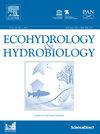湿地湖泊中真核浮游生物的大小结构和物种组成
IF 2.2
4区 环境科学与生态学
Q2 ECOLOGY
引用次数: 0
摘要
真核浮游生物在湿地湖泊生态系统中起着重要作用。然而,浅水湿地湖泊生态系统中真核浮游生物的大小结构和种类组成尚未得到充分的研究。为了弥补这一空白,本研究于2016年8月采用高通量测序和定量PCR技术对中国两个浅水湿地湖泊真核浮游生物的大小结构(pico-0.7-5 μm和nano-5-20 μm)和种类组成进行了研究。结果表明,微粒径组分的多样性指数显著高于纳米粒径组分。此外,这两个大小分数之间的群落结构存在显著差异。此外,不同的优势类群与不同的粒径相关联,某些谱系只富集于一个粒径组分。特别是,生物标记物在纳米和纳米组分之间存在差异。18S rDNA基因的丰度在两组间无显著差异。然而,基因转录物的丰度存在显著差异。此外,与纳米组分相比,纳米组分表现出更高的rRNA: rDNA比率。值得注意的是,某些分类群在特定样品中的绝对丰度较低,尽管它们的相对丰度较高。本文章由计算机程序翻译,如有差异,请以英文原文为准。
Eukaryotic plankton size structure and species composition in the wetland lakes
Eukaryotic plankton play an important role in the wetland lake ecosystems. However, the size structure and species composition of eukaryotic plankton in shallow wetland lake ecosystems remains largely unexplored. To address this gap, our study employed high-throughput sequencing and quantitative PCR techniques to investigate the size structure (pico-0.7–5 μm and nano-5–20 μm) and species composition of eukaryotic plankton in two shallow wetland lakes in China during August 2016. Our findings reveal that the diversity index values of the pico-size fraction were significantly higher than those of the nano-size fraction. Additionally, there was a significant difference in community structure between these two size fractions. Furthermore, different dominant taxa were associated with each particle size, with certain lineages being enriched exclusively in one of the size fractions. In particular, biomarkers differed between the pico- and nano- fractions. The abundance of the 18S rDNA gene did not differ significantly between the two fractions. However, there was a significant difference in the abundance of gene transcripts. Moreover, the pico- fraction exhibited a significantly higher rRNA: rDNA ratio compared to the nano- fraction. It is important to note that certain taxa had lower absolute abundance in specific samples, despite their higher relative abundance.
求助全文
通过发布文献求助,成功后即可免费获取论文全文。
去求助
来源期刊

Ecohydrology & Hydrobiology
Agricultural and Biological Sciences-Aquatic Science
CiteScore
5.40
自引率
3.80%
发文量
51
期刊介绍:
Ecohydrology & Hydrobiology is an international journal that aims to advance ecohydrology as the study of the interplay between ecological and hydrological processes from molecular to river basin scales, and to promote its implementation as an integrative management tool to harmonize societal needs with biosphere potential.
 求助内容:
求助内容: 应助结果提醒方式:
应助结果提醒方式:


